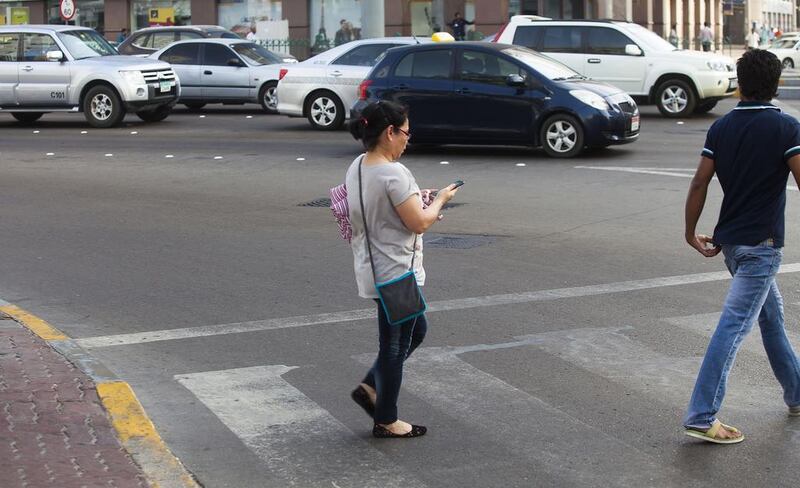ABU DHABI // We have all seen it happen: people walking along mindlessly with their head down, glued to their smartphones or listening to their iPods, and not paying any attention while crossing the road.
Road users do not give their undivided attention to the task of moving through traffic, and are at greater risk of injury or death than those who are not distracted, said Britta Lang, principal road safety scientist at British consultancy Transport Research Laboratory.
“Pedestrians, by the nature of being unprotected, are at a higher risk of injury in a collision than drivers who are protected by their vehicle,” she said. “They should be particularly vigilant when moving through the environment.”
Distracted pedestrian injuries appear to be on the rise in countries such as the United States, particularly among adolescents, she said.
Injuries to pedestrians using mobile phones have more than doubled since 2005, according to a study conducted by researchers at Ohio State University.
The study, which appeared in the August 2013 issue of the journal Accident Analysis and Prevention, found that in 2010 more than 1,500 pedestrians were treated in emergency rooms for phone related incidents compared to 559 in 2004.
Jack Naser, a co-author of the study and professor of city and regional planning at Ohio State, said there was a need to consider the danger mobile phone use poses to pedestrians.
Young people aged 16 to 25 were most likely to be injured as distracted pedestrians. Most were hurt while talking rather than texting, the study found.
“In the UAE, I see many people crossing the streets while using their mobile phone or iPod or any other device which distracts them,” said Dr Oualid Ben Ali, an assistant professor at Sharjah University. “They don’t think that they are risking their lives, and are unaware of the danger of such a behaviour.”
Thomas Edelmann, founder of the website Road Safety UAE, said it was prevalent in the Emirates.
“You can witness it everywhere and at any time,” he said. “It seems that we are all too hooked to our electronic devices. Young people especially seem to be inseparable from their devices.”
But Ms Lang said there was a lack of data in the UAE and Abu Dhabi on the prevalence of using mobile phones while driving and while crossing the road.
“There is no robust evidence on the magnitude of the problem over here,” she said. “Hence all statements are based on anecdotal evidence.”
Public awareness can be useful to direct people’s attention to the high risk they take without even thinking about it, she said.
“In terms of the psychology of permitting yourself to be distracted when participating in traffic, I think that risk of injury simply does not enter people’s minds,” said Ms Lang, who has a background in traffic psychology.“From a safety perspective we should always give our full attention to the road environment to ensure that no one comes to harm.”
Dr Oualid agreed that publicity campaigns were needed to raise awareness about the dangers of distracted walking.
“Technically we cannot provide a solution but the only solution is to install CCTVs to monitor them and give them a fine,” he said.
Hassan Al Jabri, a traffic safety ambassador in Abu Dhabi, said he was also in favour of penalising pedestrians who are distracted while crossing the road.
“Many of them are not using the designated areas to cross the road,” he said. “And they are also risking their own lives and causing damage to vehicles when motorists apply the brakes suddenly,” he said.
But imposing fines to pedestrians for distracted behaviour will be difficult to administer, Mr Edelmann said.
“It’s all about awareness and education.”
Ms Lang said it was sensible to start enforcement with vehicle drivers, while initiatives targeting pedestrians should start with education.
“The injuries created by vehicle impacts are considerably more severe,” she said. “Drivers therefore have a duty to care for other road users who are possibly more vulnerable.”
rruiz@thenational.ae






